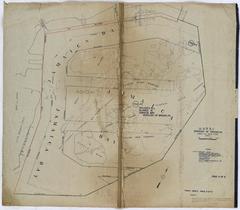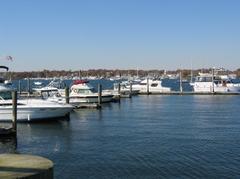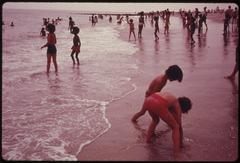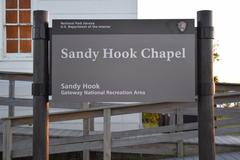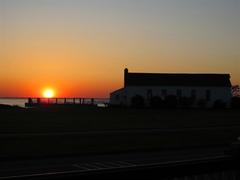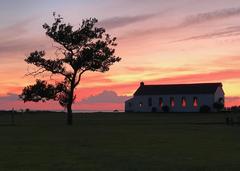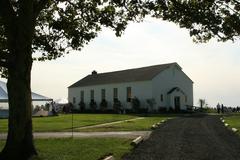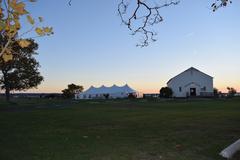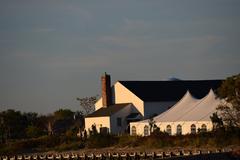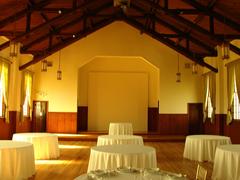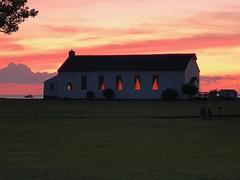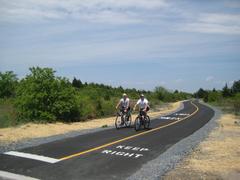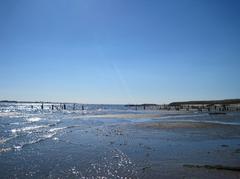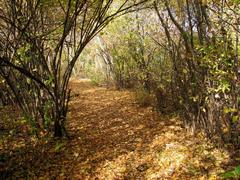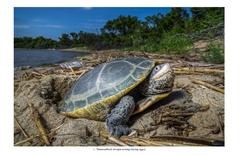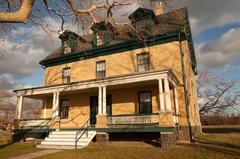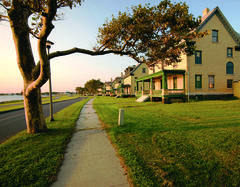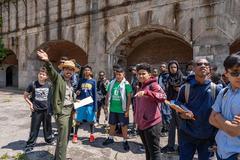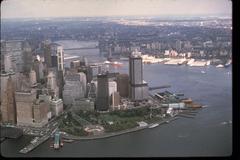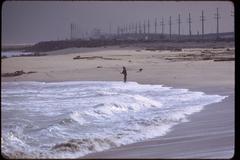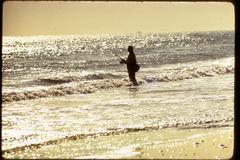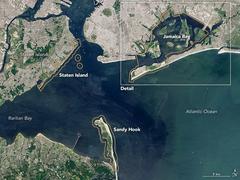
Gateway National Recreation Area: Visiting Hours, Tickets, and Attractions Guide
Date: 14/06/2025
Introduction
Gateway National Recreation Area (GNRA) is a unique urban national park that extends over 27,000 acres throughout New York and New Jersey. Established in 1972, GNRA was envisioned as a way to bring the national park experience closer to urban communities, offering city dwellers access to natural, recreational, and historical resources without leaving the metropolitan area. The park’s three major units—Jamaica Bay, Staten Island, and Sandy Hook—highlight a rich blend of ecological diversity, historic sites, and recreational opportunities (TCLF).
Within GNRA, visitors can explore historic military forts, participate in outdoor activities such as hiking, birdwatching, and swimming, and discover some of the most important wildlife habitats along the East Coast. Entry to the park is free in most areas, with modest parking fees and permits required for certain activities, ensuring accessibility for millions of residents and visitors (National Parks Foundation).
This comprehensive guide provides detailed information on visiting hours, ticketing, attractions, travel tips, and park stewardship efforts—everything you need to plan a rewarding trip to this extraordinary urban national park.
Table of Contents
- Origins and Establishment of Gateway National Recreation Area
- Historical Layers: Military, Aviation, and Urban Transformation
- Ecological and Cultural Significance
- Visiting Hours, Tickets, and Permits
- Key Sites and Their Historical Importance
- Travel Tips and Accessibility
- Challenges and Ongoing Stewardship
- Frequently Asked Questions (FAQ)
- Conclusion
- References
Origins and Establishment
GNRA was established by Congress in 1972 to address the need for accessible green space in urban areas. Unlike many traditional national parks, its lands were acquired using federal funds, reflecting a strategic shift in the National Park Service’s mission toward urban environments and recreation (TCLF).
Historical Layers: Military, Aviation, and Urban Transformation
Defense of New York Harbor
Throughout history, GNRA’s lands have played critical roles in the defense of New York Harbor:
- Fort Hancock (Sandy Hook): A coastal defense site active through World Wars I and II, featuring preserved batteries and the oldest operating lighthouse in the U.S. (NPS History & Culture).
- Fort Tilden (Jamaica Bay): A World War II coastal fortification, now a haven for wildlife and recreation.
- Fort Wadsworth (Staten Island): One of America’s oldest military installations, guarding the entrance to New York Harbor from the Revolutionary War to the Cold War.
Aviation and Urban Development
- Floyd Bennett Field: Opened in 1931 as New York City’s first municipal airport, it later became a naval air station. Today, it offers camping and recreational activities within historic hangars (TCLF).
Environmental Reclamation
- Jamaica Bay Wildlife Refuge: Transformed from a landfill into a critical wildlife refuge, now the only National Park Service-managed wildlife refuge (NPS History & Culture).
- Great Kills Park: Developed on reclaimed land, now offering beaches and trails (TCLF).
Ecological and Cultural Significance
GNRA protects vital natural habitats and offers accessible recreation to millions:
- Jamaica Bay Wildlife Refuge: A major stopover for migratory birds, with over 330 documented species and extensive wetlands (NPS History & Culture).
- Sandy Hook: Features unique maritime forests, rare coastal habitats, and abundant birdlife, including the endangered piping plover (alifeofadventures.com).
- Staten Island Unit: Supports diverse wildlife, including the only osprey nesting site on Staten Island.
GNRA’s creation was rooted in providing recreational opportunities where people live. The park is a model for urban recreation, serving over 12 million residents and tourists each year (National Parks Foundation).
Visiting Hours, Tickets, and Permits
- General Hours: Most areas are open daily from sunrise to sunset. Some visitor centers operate limited hours:
- Jamaica Bay Wildlife Refuge: Fri–Mon, 10 am–4 pm
- Ryan Visitor Center (Floyd Bennett Field): Sat–Sun, 9 am–12 pm
- Fort Wadsworth: Fri–Mon, 10 am–4 pm
- Sandy Hook: Fri–Mon, 10 am–4 pm
- For up-to-date hours, visit the NPS Gateway Hours page.
- Tickets and Fees: Entry is free. Parking fees apply at Sandy Hook ($20 during peak season; free otherwise) (alifeofadventures.com).
- Permits: Required for activities such as group camping, off-road vehicle use, and after-hours fishing. Visit the NPS Gateway Fees & Permits page for details.
Key Sites and Their Historical Importance
Jamaica Bay Unit
- Jamaica Bay Wildlife Refuge: Birdwatching, hiking, and ranger-led programs.
- Floyd Bennett Field: Historic airport, camping, and aviation exhibits.
- Canarsie Pier: Year-round fishing and picnicking.
- Jacob Riis Park: Historic beach with Art Deco architecture.
- Fort Tilden: Scenic trails and military history.
Staten Island Unit
- Great Kills Park: Beaches, salt marshes, and wildlife viewing.
- Miller Field: Former airfield with sports and picnic facilities.
- Fort Wadsworth: Military fort with guided tours and harbor views.
Sandy Hook Unit
- Sandy Hook Beaches: Seven miles of oceanfront, lifeguarded in summer.
- Fort Hancock: Army post with historic barracks and lighthouse.
- Spermaceti Cove: Nature trails and interpretive center.
Travel Tips and Accessibility
- Getting There: Accessible by car, subway, bus, and ferry. Parking at Sandy Hook can fill quickly on weekends, especially in summer.
- Public Transit: Subway access to Jamaica Bay; Staten Island Ferry connects to local buses for the Staten Island Unit; summer ferries serve Sandy Hook.
- Accessibility: Visitor centers, restrooms, and several trails are wheelchair accessible. Beach wheelchairs are available at Sandy Hook and Jacob Riis Park (NPS Accessibility).
- Facilities: Restrooms, showers, concessions, and picnic areas are available at major sites.
- Pets: Leashed pets are allowed in most areas except lifeguarded beaches during summer and certain wildlife protection zones.
Challenges and Ongoing Stewardship
Climate Change and Resilience
GNRA faces ongoing threats from sea-level rise, storms, and habitat loss. Following Superstorm Sandy in 2012, restoration and resilience projects have been implemented to protect infrastructure and ecosystems (TCLF).
Preservation of Cultural Resources
The park preserves and interprets its historic military buildings, lighthouses, and airfields through tours, exhibits, and educational programs (americasbesthistory.com).
Frequently Asked Questions (FAQ)
Q: What are the Gateway National Recreation Area visiting hours?
A: Most areas are open daily from sunrise to sunset. Visitor centers have specific hours—check the NPS website.
Q: Are tickets or permits required?
A: General entry is free. Parking fees apply at Sandy Hook during summer. Permits are needed for some activities—see NPS details.
Q: Is the park accessible for people with disabilities?
A: Many facilities are accessible, including beach wheelchairs at select locations.
Q: Can I camp in the park?
A: Yes, at Floyd Bennett Field (Brooklyn) and Sandy Hook (seasonal). Reservations required via Recreation.gov.
Q: Are dogs allowed?
A: Leashed dogs are permitted except on lifeguarded beaches during summer and in certain wildlife areas.
Conclusion
Gateway National Recreation Area offers a rare opportunity to enjoy natural beauty, historic sites, and recreation within an urban context. With its diverse habitats, rich history, and accessible amenities, GNRA stands as a model for urban park stewardship and public engagement. Always check current hours, permits, and event schedules before your visit, and take advantage of ranger-led programs and guided tours for a deeper experience. Download the Audiala app for personalized guides and real-time updates, and follow the park on social media for the latest news.
Whether you’re a history enthusiast, nature lover, or city explorer, GNRA is your gateway to adventure just outside New York City’s urban core (NPS Gateway).
References
- Gateway National Recreation Area: Visiting Hours, Tickets, and Exploring New York’s Historic Urban Park, 2024, The Cultural Landscape Foundation (TCLF)
- Gateway National Recreation Area: Visiting Hours, Tickets, and Top Historical Sites in New York City, 2024, National Park Service (NPS Gateway)
- Gateway National Recreation Area Visiting Hours, Tickets, and Key Sites: Your Complete Guide, 2024, National Park Service (NPS Gateway)
- Gateway National Recreation Area Visiting Hours, Tickets, and Travel Guide, 2024, National Park Service (NPS Gateway)
- Gateway National Recreation Area, National Parks Foundation (National Parks Foundation)
